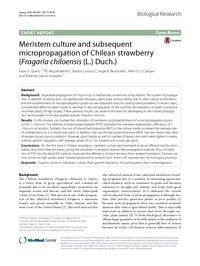Mostrar el registro sencillo de la publicación
Meristem culture and subsequent micropropagation of Chilean strawberry (Fragaria chiloensis (L.) Duch.)
| dc.contributor.author | Quiroz, Karla | |
| dc.contributor.author | Berríos- Muñoz, Miguel | |
| dc.contributor.author | Carrasco, Basilio | |
| dc.contributor.author | Retamales, Jorge B. | |
| dc.contributor.author | Caligari, Peter D. S. | |
| dc.contributor.author | García-González, Rolando | |
| dc.date.accessioned | 2017-09-11T13:05:51Z | |
| dc.date.available | 2017-09-11T13:05:51Z | |
| dc.date.issued | 2017 | |
| dc.identifier.uri | http://repositorio.ucm.cl/handle/ucm/131 | |
| dc.description.abstract | Background: Vegetative propagation of Fragaria sp. is traditionally carried out using stolons. This system of propaga‑ tion, in addition to being slow, can spread plant diseases, particularly serious being viral. In vitro culture of meristems and the establishment of micropropagation protocols are important tools for solving these problems. In recent years, considerable efort has been made to develop in vitro propagation of the commercial strawberry in order to produce virus-free plants of high quality. These previous results can serve as the basis for developing in vitro-based propaga‑ tion technologies in the less studied species Fragaria chiloensis. Results: In this context, we studied the cultivation of meristems and establishment of a micropropagation proto‑ col for F. chiloensis. The addition of polyvinylpyrrolidone (PVP) improved the meristem regeneration efciency of F. chiloensis accessions. Similarly, the use of 6-benzylaminopurine (BAP) in the culture media increased the average rate of multiplication to 3–6 shoots per plant. In addition, the use of 6-benzylaminopurine (BAP), had low levels (near zero) of explant losses due to oxidation. However, plant height as well as number of leaves and roots were higher in media without growth regulators, with average values of 0.5 cm, 9 leaves and 4 roots per plant. Conclusions: For the frst time in Chilean strawberry, meristem culture demonstrated to be an efcient tool for elimi‑ nating virus from infected plants, giving the possibility to produce disease free propagation material. Also, the addi‑ tion of PVP into the basal MS medium improved the efciency of plant recovery from isolated meristems. Farmers can now access to high quality plant material produced by biotech tools which will improve their technological practices | es_CL |
| dc.language.iso | en | es_CL |
| dc.rights | Atribución-NoComercial-SinDerivadas 3.0 Chile | * |
| dc.rights.uri | http://creativecommons.org/licenses/by-nc-nd/3.0/cl/ | * |
| dc.source | Biological Research, 50, 20 | es_CL |
| dc.subject | Fragaria chiloensis | es_CL |
| dc.subject | Meristem culture | es_CL |
| dc.subject | Plant growth regulators | es_CL |
| dc.subject | Virus elimination | es_CL |
| dc.subject | Plant morphogenesis | es_CL |
| dc.title | Meristem culture and subsequent micropropagation of Chilean strawberry (Fragaria chiloensis (L.) Duch.) | es_CL |
| dc.type | Article | es_CL |
| dc.ucm.facultad | Facultad de Ciencias Agrarias y Forestales | es_CL |
| dc.ucm.indexacion | Scopus | es_CL |
| dc.ucm.indexacion | Isi | es_CL |
| dc.ucm.indexacion | Scielo | es_CL |
| dc.ucm.doi | doi.org/10.1186/s40659-017-0125-8 | es_CL |



